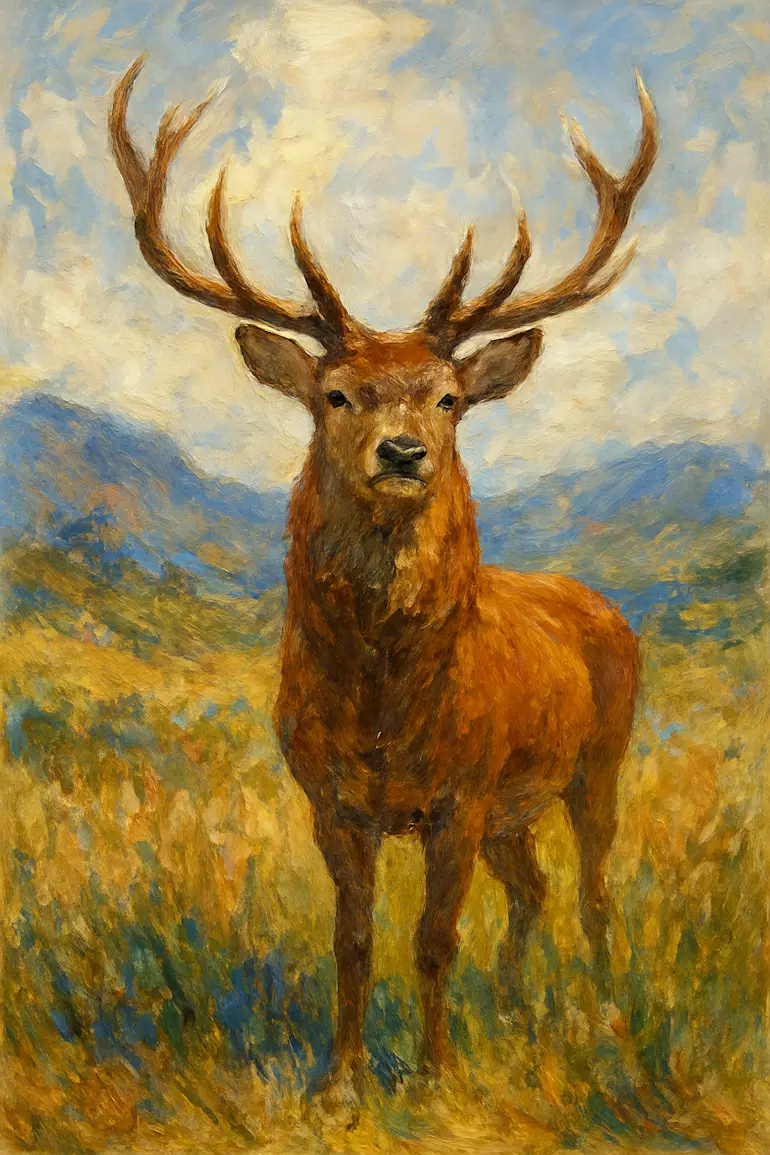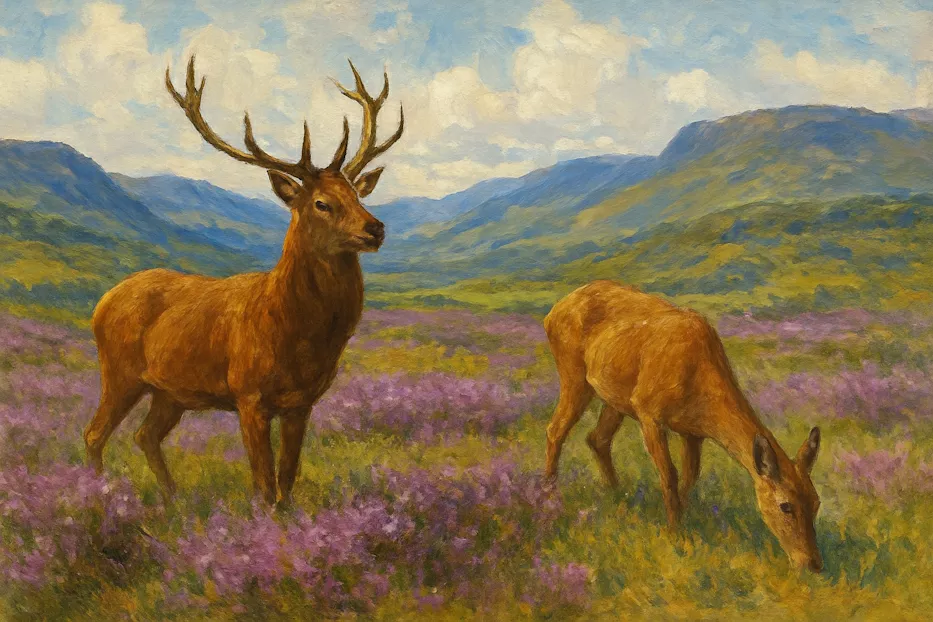The Scottish Red Deer (Cervus elaphus scoticus) roams the rugged, heather-clad hills and ancient forests of Scotland, a living emblem of the Highlands.
As Scotland’s largest wild land mammal and the biggest of all British deer species, the red deer is an unforgettable sight. Encountering a colossal stag with a crown of branching antlers is a quintessential Scottish experience, a powerful connection to the wild heart of this northern nation.
This in-depth article will explore the life, habitat, behaviour, and conservation of this iconic species, providing an essential guide for wildlife enthusiasts, photographers, and anyone keen to delve into the natural history of the Scottish wilderness.
Table of Contents
Why the Red Deer is Scotland’s True Monarch
Size, Stature, and the Iconic Antlers
The moniker “Monarch of the Glen” isn’t merely a romantic nickname; it reflects the commanding presence of the mature male red deer. These magnificent animals dominate the landscape, especially during the autumn mating season.
Size and Weight:
- Stags (males) are substantially larger than hinds (females).
- A mature stag can stand up to 1.2 metres (3.9 feet) at the shoulder and weigh between 100 and 225 kilograms (220 to 500 lbs), with some larger specimens exceeding this range.
- Their coats are typically a dark, reddish-brown in summer, transitioning to a thicker, greyer-brown in winter for insulation. They possess a distinctive pale rump patch and a short, buff tail.
The Antler Crown: The most striking feature of the stag is its elaborate rack of antlers. These are not permanent horns but rapidly growing structures made of bone, shed and regrown annually, usually between late spring and early summer.
- Antlers can measure up to one metre (about 3 feet) in breadth and weigh up to 15 kg (around 33 pounds).
- They grow while covered in a soft, vascular skin known as “velvet,” which supplies blood and nutrients. Once fully grown, the velvet is scraped off against trees and shrubs (a process called fraying).
- Antler size and complexity generally increase with the stag’s age and health, serving as a powerful visual display of dominance and fitness to rival males and potential mates.

Life in the Wild: Habitat and Social Structure
From Forest Dweller to Hill Roamer
Historically, the red deer was a woodland species. However, widespread deforestation in Scotland centuries ago forced the majority of the population to adapt to living on the open moorland, grasslands, and mountainsides of the Highlands and islands. This has resulted in a hardier, though slightly smaller, subspecies known as the Scottish Red Deer (Cervus elaphus scoticus).
Habitat: Red deer are incredibly adaptable herbivores. Their diet consists mainly of:
- Grasses, sedges, and rushes.
- Dwarf shrubs like heather.
- Tree bark and young saplings, which is why their grazing can impact woodland regeneration—a key conservation issue.
Social Dynamics: Red deer are highly social animals, living in separate-sex herds for most of the year:
- Hinds live in matriarchal herds (led by an older female) with their young and sub-adult offspring.
- Stags group together in bachelor herds, often at higher altitudes, reserving their energy until the breeding season.
The Autumn Spectacle: The Red Deer Rut
Roars, Rumbles, and Antler Clashes
The most dramatic time to witness the red deer is during the rut, or breeding season, which typically runs from mid-September to late October. This annual phenomenon is one of the most spectacular wildlife displays in the British Isles.
The Bellowing Challenge: As autumn descends, stags descend from their summer grounds and begin to compete intensely for the right to mate with the hind herds.
- The hills echo with the bellowing or roaring of the stags—deep, resonant calls used to attract hinds and warn off rivals.
- A dominant stag, known as a ‘master stag’ or ‘beast office the rut,’ will aggressively defend his harem of hinds.
The Fight for Dominance: When a challenger is not deterred by a roar or a parallel walk display (where stags walk side-by-side to assess each other’s size and strength), a violent clash ensues.
- The stags will lower their heads and lock their massive antlers together.
- The ensuing battle is a ferocious contest of strength, endurance, and strategy, pushing and shoving until one combatant concedes defeat. Injuries, though rare, can be fatal.
Calf Birth: Following a successful mating, hinds will usually give birth to a single, spotted calf in late May or June, which remains hidden for its first few weeks before joining the herd.
The Wider Picture: Management and Conservation
A Species of ‘Least Concern’ but Facing Modern Challenges
The red deer population in Scotland is strong, estimated to be well over 300,000, and is classified globally as of “Least Concern“ on the IUCN Red List. However, their numbers and impact on the delicate Scottish ecosystem require careful management.
Impact on the Landscape: With the natural predators like the wolf and bear having been extinct in the UK for centuries, the Scottish Red Deer population lacks natural control. This has led to high densities in some areas, resulting in:
- Overgrazing, which prevents the natural regeneration of native trees and plants, thus impacting biodiversity.
- Damage to forestry and agricultural land.
Deer Management: To mitigate these impacts, deer populations in Scotland are managed through licensed culling (or deer stalking), which is undertaken by estates, private landowners, and conservation bodies like NatureScot. This is a regulated activity aimed at maintaining a healthy balance between the deer population and the habitat’s carrying capacity.
Hybridisation Threat: Another modern challenge is the increasing hybridisation with the smaller, introduced Sika Deer (Cervus nippon), which can lead to a dilution of the native Scottish Red Deer gene pool in certain regions.
Responsible Wildlife Watching: For the public, the best way to support the continued health of this species is through responsible wildlife watching. Always maintain a respectful distance—at least a few hundred metres, especially during the rut—to avoid causing stress or disturbance to the animals. Bring good binoculars or a camera lens to enjoy the spectacle safely.
SCOTLAND FERRY TICKETS
Where to Spot Scotland’s Red Deer
While prevalent across the Highlands, some locations offer particularly reliable sightings of this spectacular mammal:
- The Isle of Arran: Famous for its large, relatively accessible herds.
- The Cairngorms National Park: Home to a significant portion of the Scottish population, including both red and roe deer.
- Glen Coe and Rannoch Moor: Classic Highland landscapes where deer are often seen grazing near the roadside.
- Knapdale and the Isle of Jura: Coastal and island populations offer unique viewing opportunities.
Whether you’re observing a lone stag silhouetted against a mountain ridge or a herd of hinds traversing a misty glen, the Scottish Red Deer embodies the wild, untamed spirit of the Highlands. It is a vital and spectacular component of the nation’s natural heritage, a true king of the British wilderness.

